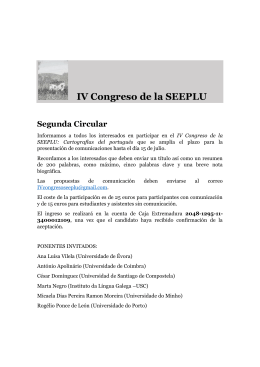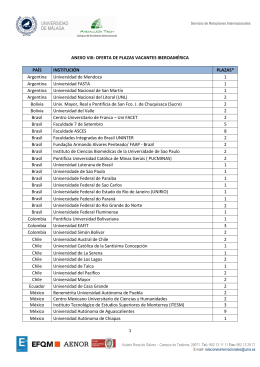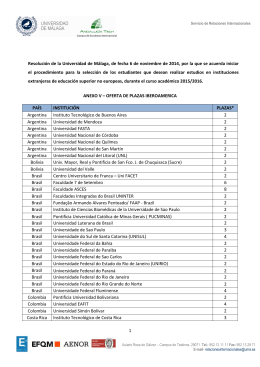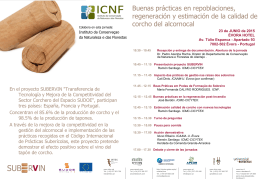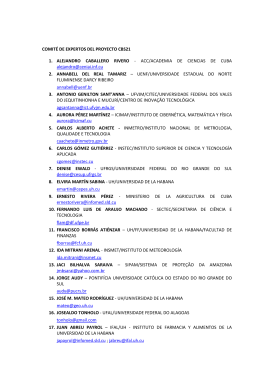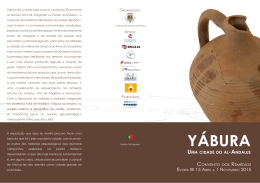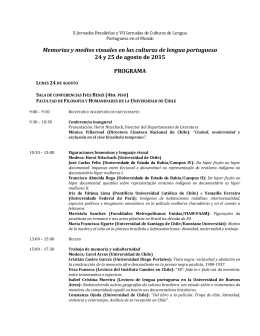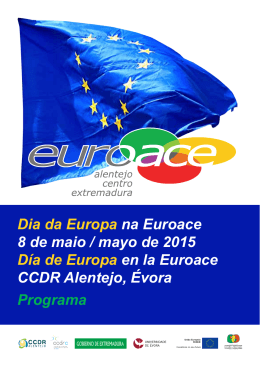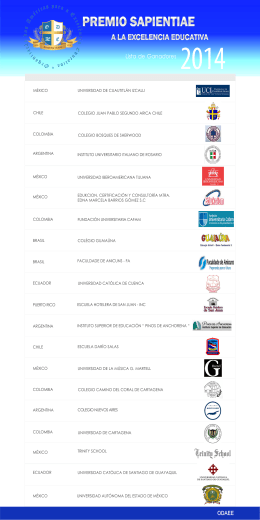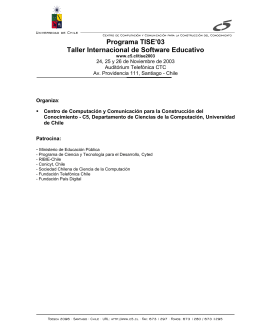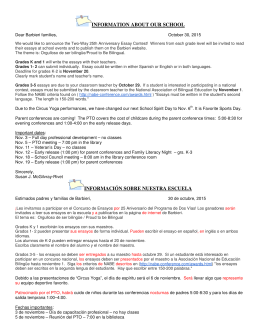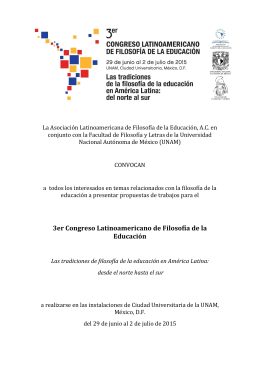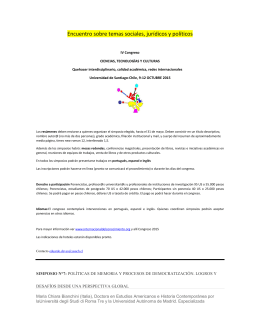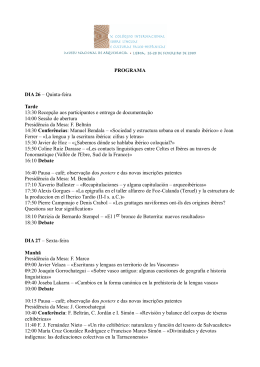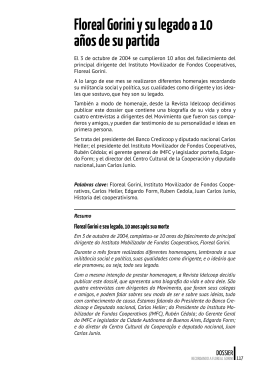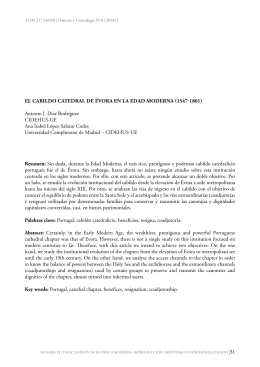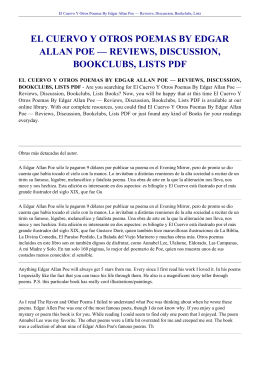CICLO DE CONFERÊNCIAS EM ARTE, CULTURA VISUAL E NOVAS TECNOLOGIAS Universidade de Évora IIFA - INSTITUTO DE INVESTIGAÇÃO E FORMAÇÃO AVANÇADA CHAIA - CENTRO DE HISTÓRIA DA ARTE E INVESTIGAÇÃO ARTÍSTICA DEPARTAMENTO DE ARTES VISUAIS E DESIGN MAIO e JUNHO de 2011 0 CALENDÁRIO do Ciclo de Conferências, 2011: Artes Visuais e Teoria das Artes Plano dos Ciclos de Conferências Ano e Semestre Professores Nº de Crédito DATA e PREÇO HORAS ECTS IDIOMA INDIVIDU TIPO AL Ciclo conferência Aurora F. de Teoria das artes Polanco T 12 0,5 13 e 14.05. 60,00 * Espanhol visuais Ciclo de Eduardo Kac T 12 0,5 17 e 18.06 60,00 * conferência Novas tendências da Português Media Art: Arte e Ciência, Bioarte TOTAL ECTS 1,0 Preço: Professores da Universidade de Évora, Membros do CHAIA e Estudantes matriculados na Universidade de Évora: 25,00 Euros Funcionamento dos ciclos de conferências Os interessados poderão inscrever-se em ambos ciclos de conferências ou separadamente. O CHAIA dará um certificado de assistência, no qual constará o n.º de horas e créditos ECTS correspondentes. As conferências serão nas sextas-feiras, de 10:00-13:00 e de 15:00-19:00 e sábados, de 10:00-13:00 e de 16:00-18:00 h no Colégio do Espírito Santo (Reitoria) e/ou no Departamento de Artes Visuais e Design da Universidade de Évora. Objectivos do ciclo de conferências - Proporcionar conhecimentos transdisciplinares de grande actualidade sobre questões conceptuais, formais e práticas levantadas a partir do vínculo entre as práticas artísticas, os estudos culturais e as novas tecnologias digitais. - A formação de especialistas nas áreas afins das conferencias. - Favorecer o diálogo entre estudantes e professores, e abrir novos horizontes e contactos profissionais a partir das relações humanas no âmbito das conferências. Conteúdos das conferências Aurora Fernández Polanco Visión, modernidad y crisis de la experiencia. Imagen e imaginación en la cultura visual global. Pensar con imágenes: del ensayo como forma a la forma como ensayo. Archivo, montaje y legibilidad de la(s) historia(s): de Warburg a Godard. Más allá del archivo: mapas y operaciones digitales. Eduardo Kac Since the early 1960s the social impact of computer technology has been a dominant issue and since the early 1980s the digital revolution has been provoking profound changes in the way we live. Now, in the twenty-first century, we realize that the next frontier of artistic investigation is biotechnology. The field of biological studies is changing from a life science into an information science. A few this change and are contemporary artists have been responding to already working with transgenics, interspecies communication, cloning, tissue culture and hybridization techniques to redefine the boundaries between the artwork and living organisms. This seminar will discuss the complex relationship between biology and art in the larger context of related social, political, and ethical issues. Requisitos de acesso: Não há exames para a admissão nos ciclos de conferências. Envio do CV a [email protected] Informação sobre o ciclo de conferências Descrição geral Ciclo de Arte, Cultura Visual e Novas Tecnologias Certificado conferido Certificado do CHAIA de assistência N.º ECTS Corresponde a 0,5 ECTS cada. Número de vagas 10 Valor da propina Cada ciclo de conferência: 60,00 Euros. Professores da Universidade de Évora, Membros do CHAIA e Estudantes matriculados na Universidade de Évora: 25,00 Euros. Organiza Departamento de Artes Visuais e Design, CHAIA e IIFA Inscrição PERÍODO DE INSCRIÇÃO Até no máximo uma semana antes da data da conferencia. COMO PROCEDER À INSCRIÇÃO Enviar candidatura com dados completos (nome completo, morada e contactos, nº de BI e NIF) e CV para: [email protected] Receberá uma confirmação via email, a partir da qual poderá proceder ao pagamento da inscrição. Pagamento da inscrição: por multibanco ou transferência na conta nº 0035 0297 0006796113073 da Caixa Geral de Depósitos. Será necessária a apresentação do talão de pagamento do multibanco a anexar à ficha de inscrição. Directora do CHAIA Director do IIFA Dra. Christine Zurbach Dr. Soumodip Sarkar Coordenadora do ciclo de conferências Dra. Claudia Giannetti Para mais informações Contacto: Dra. Claudia Giannetti [email protected] Secretariado: Carmen Cangarato tel: (00 351) 266 706 581 Horário: Segunda a Sexta-feira, 9:00-12:30, 14:00-17:30 h Email: [email protected] Endereço: Centro de História da Arte e Investigação Artística Palácio do Vimioso, Largo Marquês de Marialva, 8 / 7002-554 Évora http://www.chaia.uevora.pt 2 Universidade de Évora / Departamento de Artes Visuais e Design / CHAIA / IIFA BREVE BIOGRAFIA DOS PROFESSORES Aurora Fernández Polanco Studied History of Art and got her Ph.D at the Universidad Complutense of Madrid. She is currently a Professor and chair of the Section of Theory and History of Contemporary Art, Department of Fine Arts (Universidad Complutense). She has been member of several research teams (R+D), such as “Representaciones de la violencia y el mal en el arte y la cultura contemporánea” and “Arte y Política: Argentina, Brasil, Chiles y España. 1989-2008”. At the moment, she is in charge of the project “Imágenes del Arte y reescritura de las narrativas en la cultura visual global” (R+D). She has published extensively on the perceptive changes in the interpretation of actual art. Her works include Formas de mirar en el arte actual, Madrid, 2004; “De Baudelaire a Warhol” in ACTO, Revista de pensamiento artístico 0, 2001; “Sobre algunas metáforas psicoanalíticas en la estética contemporánea” in S. Alemán & N. Caparrós (eds.), Madrid, 2002. She is co-editor of La Distancia y la Huella: para una antropología de la mirada, Cuenca, 2001 and Las imágenes del arte todavía, Cuenca, 2006 and editor of Cuerpo y mirada: huellas del siglo XX, Madrid, 2007. Aurora F. Polanco has also given lectures and organized seminars and courses about the problems connecting memory and visuality, such as “Memoria, Historia, Montaje y Representación” in La Memoria Pública, S. Aznar (ed.), Madrid, 2003; “Shoah y el debate Lanzman (Moisés) /Godard (San Pablo)“ in Er, Revista de Filosofía 33, 2004; “Historia, montaje e imaginación: sobre imágenes y visibilidades” in Imágenes de la violencia en el arte contemporáneo, V. Bozal (ed.), Madrid, 2005; “Pensar con imágenes: historia y memoria en la época de la googleización” in Arte y Política: Argentina, Brasil, Chile y España, 1989-2004. Madrid, 2009. Finally, she has been artistic director and catalog editor at the exhibition Basilio Martin Patino: Espejos en la niebla, Madrid CBA, 2008. And she has curated the exhibitions La visón impura. Fondos del Museo Nacional Centro de Arte Reina Sofia. Madrid, MNCARS, 2006; Alois beer: un viaje en 3D por la España de 1900. Valladolid, Salamanca, 2007; Mireia Sentis: Fotografías 1983-2008.Madrid, CBA, 2008 and Mireia Sentis Fotografia/Assaig/Comunicació, Barcelona Art Santa Mónica, 2009. 3 Universidade de Évora / Departamento de Artes Visuais e Design / CHAIA / IIFA Eduardo Kac http://www.ekac.org Media artist. Full Professor of Art and Technology, Art and Technology Department, The School of the Art Institute of Chicago. Eduardo Kac is internationally recognized for his telepresence and bio art. A pioneer of telecommunications art in the pre-Web '80s, Eduardo Kac (pronounced "Katz") emerged in the early '90s with his radical works combining telerobotics and living organisms. His visionary integration of robotics, biology and networking explores the fluidity of subject positions in the post-digital world. His work deals with issues that range from the mythopoetics of online experience (Uirapuru) to the cultural impact of biotechnology (Genesis); from the changing condition of memory in the digital age (Time Capsule) to distributed collective agency (Teleporting an Unknown State); from the problematic notion of the "exotic" (Rara Avis) to the creation of life and evolution (GFP Bunny). At the dawn of the twenty-first century Kac opened a new direction for contemporary art with his "transgenic art"--first with a groundbreaking transgenic work entitled Genesis (1999), which included an "artist's gene" he invented, and then with his fluorescent rabbit called Alba (2000). From his first experiments online in 1985 to his current convergence of the digital and the biological, Kac has always investigated the philosophical and political dimensions of communication processes. Equally concerned with the aesthetic and the social aspects of verbal and non-verbal interaction, in his work Kac examines linguistic systems, dialogic exchanges, and interspecies communication. Kac's pieces, which often link virtual and physical spaces, propose alternative ways of understanding the role of communication phenomena in creating shared realities. Kac merges multiple media and biological processes to create hybrids from the conventional operations of existing communications systems. Kac first employed telerobotics in 1986 motivated by a desire to convert electronic space from a medium of representation to a medium for remote agency. He creates pieces in which actions carried out by Internet participants have direct physical manifestation in a remote gallery space. Often relying on the indefinite suspension of closure and the intervention of the participant, his work encourages dialogical interaction and confronts complex issues concerning identity, agency, responsibility, and the very possibility of communication. Kac’s work has been exhibited internationally at venues such as Exit Art and Ronald Feldman Fine Arts, New York; Maison Européenne de la Photographie, Paris, and Lieu Unique, Nantes, France; OK Contemporary Art Center, Linz, Austria; InterCommunication Center (ICC), Tokyo; Julia Friedman Gallery, Chicago; Seoul Museum of Art, Korea; and Museum of Modern Art, Rio de Janeiro. Kac's work has been showcased in biennials such as Yokohama Triennial, Japan, Bienal de Sao Paulo, Brazil, and Gwangju Biennale, Korea. His work is part of the permanent collection of the Museum of Modern Art in New York, the ZKM Museum, Karlsruhe, Germany, and the Museum of Modern Art in Rio de Janeiro, among others. Kac's work has been featured both in contemporary art publications (Flash Art, Artforum, ARTnews, Kunstforum, Tema Celeste, Artpress, NY Arts Magazine) and in the mass media (ABC, BBC, PBS, Le Monde, Boston Globe, Washington Post, Chicago Tribune, New York Times). Kac has received many awards, including the Golden Nica Award, the most prestigious award in the field of media arts and the 4 Universidade de Évora / Departamento de Artes Visuais e Design / CHAIA / IIFA highest prize awarded by Ars Electronica. He lectures and publishes worldwide. His work is documented on the Web in eight languages: http://www.ekac.org. Kac is a member of the editorial board of the journal Leonardo, published by MIT Press. Kac's writings on art, which have appeared in several books and periodicals in many countries, have been collected in two volumes: Telepresence and Bio Art : Networking Humans, Rabbits and Robots (Ann Arbor: University of Michigan Press, 2005) and Luz & Letra (Rio de Janeiro: Contra Capa, 2004). Kac's poetry is collected in Hodibis Potax (Édition Action Poétique, Ivry-sur-Seine (France) and Kibla, Maribor (Slovenia), 2007). Books about Kac's work include: Eduardo Kac : Move 36, Elena Giulia Rossi, editor (Paris : Filigranes Éditions, 2005), The Eighth Day: The Transgenic Art of Eduardo Kac, Sheilah Britton and Dan Collins, eds. (Tempe: ISA/ASU - New York: DAP, 2003) and Eduardo Kac (Valencia: IVAM, 2007). 5 Universidade de Évora / Departamento de Artes Visuais e Design / CHAIA / IIFA
Download
